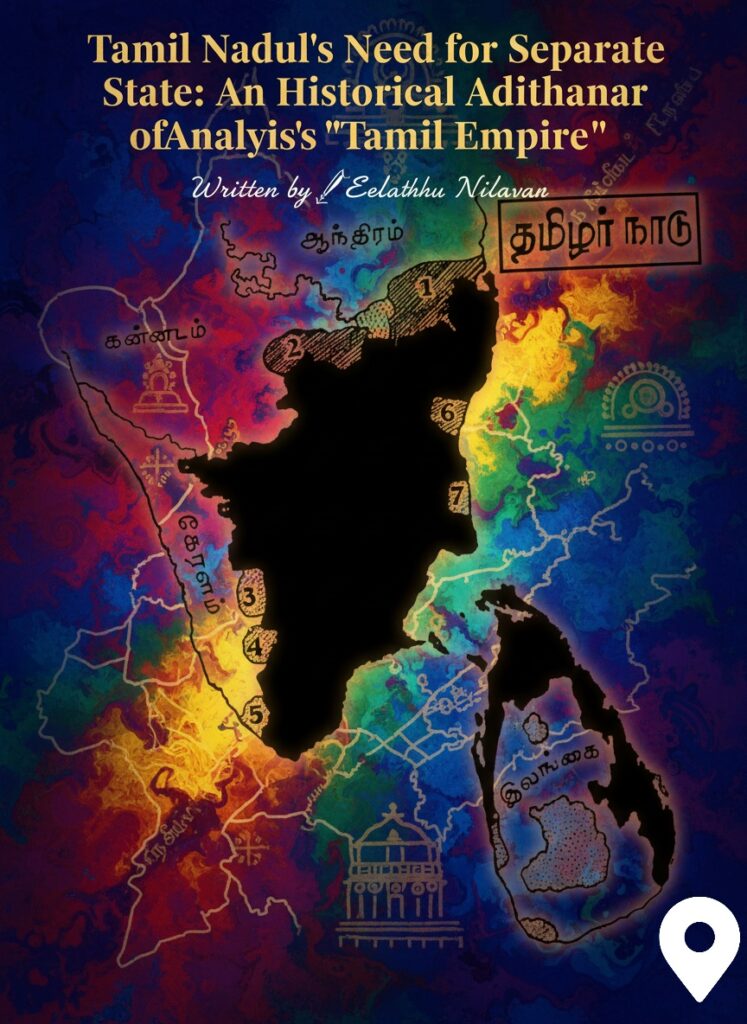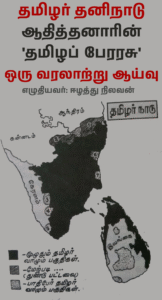Introduction
C. P. Adithanar was a pioneer of the Tamil nationalist ideology. Boldly advocating for a separate nation for Tamil Nadu, he stood slightly apart from the rising Dravidian movement of his time, championing a pure form of Tamil Nationalism. His book, Tamizhap Perarasu (‘Tamil Empire’) (1965), comprehensively detailed the economic, geographical, political, and historical justifications for the demand for a separate state. Adithanar’s arguments, voiced during a period when the unity of India was considered sacrosanct, marked a turning point in Tamil Nadu’s political history. This article analyzes the key arguments of Adithanar’s secessionist demand, the political context of the era, and his foresight.

Adithanar’s Argument on Economic Exploitation
The core of Adithanar’s demand for a separate state was the argument of economic exploitation. In his 1965 calculation, he estimated that the Delhi government had plundered ₹2,460Crores from Tamil Nadu in the 18 years from 1947. This figure indicated a massive economic disparity at the time.
● Tax Allocation and Tribute: Adithanar condemned the fact that taxes collected by the Central Government flowed north, with the majority of the expenditure also taking place there, thereby economically disadvantaging Tamil Nadu. He compared this relationship to the tribute paid by minor chieftains out of fear of emperors. He stressed that the relationship with Delhi was not one of equitable federalism, but rather of oppressive exploitation.
● The Deceit of Paper Currency: Adithanar’s view on rupee notes was notable. He claimed that Delhi had plundered goods equal to the value of the paper currency in circulation in Tamil Nadu, and in return, had deceptively given back mere paper notes as currency. This was a far-sighted observation that pointed out the subtle economic exploitation occurring through monetary policy.
● Sustained Loss and Poverty: Adithanar calculated that if the situation persisted after 1965, Tamil Nadu would incur an annual loss of ₹120 Crores. Furthermore, he noted with concern that 2,500 people were committing suicide annually, attributing it to poverty, for which Delhi’s exploitation played a significant role.
Opposition to Population Control Policy
Adithanar staunchly opposed the population control measures enforced by the Central Government in Tamil Nadu.
● Concern for Ethnic Survival: While population control programs were rigorously implemented in Tamil Nadu, they were rapidly increasing in the North. Adithanar feared that in the future, the Tamil population would drastically decrease, endangering the survival of the ethnic group itself.
● The Analogy of “Cutting the Foot to Fit the Shoe”: He harshly condemned population reduction using the metaphor of “cutting the foot to fit the shoe.” Adithanar believed that such control was not a permanent solution to poverty; rather, it was a conspiracy to reduce the ethnic population and weaken its political power.
Arguments on Geography and Water Rights
Adithanar’s rebuttal to the then-MLA Kuzhandai Ammaal’s statement that “Tamil Nadu is a dry land, unfit to be an independent state,” and the Dinamani editorial on the same topic, revealed his deep insight into water rights.
● Water Deprivation and Solution: Adithanar pointed out that rivers like the Palar were running dry because dams were being built and water stored in Mysore (Karnataka). He argued that because Tamil Nadu was under Delhi’s dominance, it could not take action. If it became an independent nation, it could legally demand the release of water based on the rights of sovereign nations. Furthermore, he stated that independent Tamils could implement projects to utilize the waters of rivers like the Cholayar and Parambikulam, which flow through Malayalam-speaking areas. He also asserted that a nation’s wealth is not determined solely by its rivers.
● Cauvery and International Rules: He dismissed the fear of losing Cauvery river water as a baseless rumour. Just like international rivers such as the Brahmaputra (India, China, Pakistan) and the Danube (6 European nations), the Cauvery allocation is governed by global rules. He argued that if these rules were violated, the matter could be resolved in the United Nations or the World Court. Thus, he strongly contended that the idea of losing Cauvery water if Tamil Nadu became independent was a hoax; instead, Tamils would regain lost water rights. This demonstrated his early awareness of International Water Law.
List of Small Countries and the Feasibility of Separate Statehood
Adithanar used a list of other nations to solidify his argument.
● 106 Smaller Nations: He questioned why Tamil Nadu could not become a separate nation when 106 countries smaller than it were already independent. His publication of the list of these 105 nations and their populations proved that separate statehood was not an illusion but a global reality.
Minority Status and an Alternative View on Dravidianism
Adithanar precisely analyzed the problems arising from the Tamil people being a political minority.
● Troubles of the Minority: He highlighted that in the Delhi Parliament, there were only 40 Tamils compared to 460 non-Tamils, leading to all problems stemming from the Tamils’ minority status. He insisted that only by seceding could Tamils achieve a majority status.
● Skepticism about Dravidian Separation: Adithanar argued that even if Tamils joined Kannadigas, Telugus, and Malayalis to form a Dravidian entity, there would be 4.5 crore Tamils versus 10 crore non-Tamils. Thus, Tamils would still be a minority, and the troubles would persist. This view, which contradicted the core Dravidian movement ideology, signifies a pure Tamil Nationalist perspective.
● The Example of the Jews: He cited the history of the Jews as proof that an ethnic group thrives when it overcomes its minority status, pointing out that the troubles of the 8 lakh scattered Jews ceased after they formed the independent state of Israel in 1948.
Tamil Nadu and Eelam: The ‘Tamil Rajyam’ Dream
Adithanar’s Tamil nationalist thought did not stop at Tamil Nadu; he also highlighted the suffering of the Eelam Tamils and the dream of uniting all Tamil-inhabited areas into a single nation, the ‘Tamil Rajyam.’
● The 1942 ‘Tamil Rajyam’: As early as 1942, he wrote the book Tamil Rajyam and published a map outlining all Tamil-inhabited regions.
● Areas to be United:

︎ Pondicherry, Karaikal

︎ Peerumedu, Devikulam, Neyyattinkara (areas seized by Malayalis)

︎ Tamil regions up to Vengadam on the northern border (areas in Andhra Pradesh)

︎ North Sri Lanka (a part of Tamil Nadu separated by a small 18-mile strait)
● What Constitutes Treachery?: If splitting the Indian nation was treachery, Adithanar asked, “Isn’t it treachery against the Tamils that Tamil Nadu is fragmented?” He asserted that this fragmented state was the reason for the weakness of the Tamil community, and that it was the legitimate aspiration of the Tamil race for all these areas to unite and form a sovereign Tamil Nadu and become a great power.
● The Suffering of Eelam Tamils (1958, 1961): He referenced the killings and the destruction of property worth over one crore rupees suffered by Tamils at the hands of Sinhala fanatics in April-May 1958, calling it ten times more horrific than the Punjab massacre. He also pointed out the untold hardships Tamils faced under military rule in Sri Lanka since February 1961. He argued that only with a separate Tamil government would 35 lakh Sinhalese not dare to mock 5 crore Tamils or chase them away as illegal immigrants.
Tamil Liberation: The Power to Rise Up
Finally, his argument on the possibility of Tamil liberation was a call for political self-confidence.
● The World Cannot Stop It: Adithanar proclaimed: “If 5 crore Tamil people realize they are one race and rise up to break their shackles of slavery, the world, even if it unites, cannot stop it! Neither can the Delhi government! Nor can the 38 crore North Indians who support that government!”
● The Example of Ireland: By citing the inability of the English, who outnumbered the Irish by 15 times, to suppress the freedom struggle of 30 lakh Irish people, he established that the political will of the Tamils was powerful.
Conclusion
C. P. Adithanar’s Tamizhap Perarasu is an indispensable document in the political history of pure Tamil Nationalism. Amidst the rise of the Dravidian movement in the 1960s, he uniquely put forward the demand for a separate state with compelling economic, social, and geographical justifications. His estimations (especially regarding economic exploitation, population control, and water rights) accurately reflect the challenges of the India-Tamil Nadu relationship that persist to this day. The historical event where his ‘Tamil Rajyam Coalition’ defeated the Congress before Annadurai, only to be prevented by the Central Government via the Governor from rightfully becoming the Chief Minister, confirms the potent political threat he represented. Overall, Adithanar’s vision remains the enduring symbol of the dream of an independent Tamil Nadu—a great power that would break the chains of servitude and unite the scattered Tamil lands.

Written by: Eelaththu Nilavan
Tamil National Historian, Analyst of Global Politics, Human Rights, Economics, Intelligence, and Military Affairs
21/10/2025
The views expressed in this article are the author’s own and do not necessarily reflect Amizhthu’s editorial stance.



